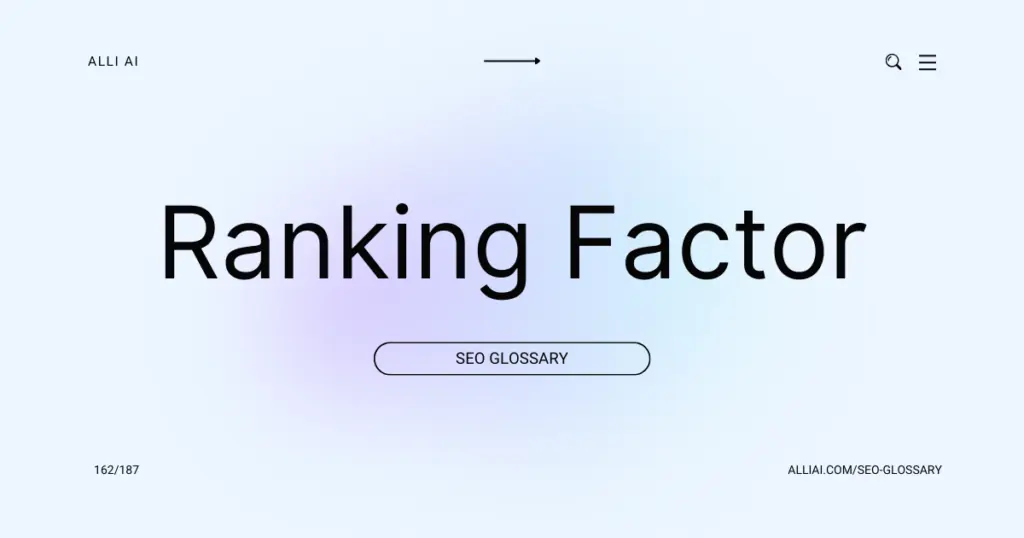What Does Ranking Factor Mean?
A ranking factor in SEO refers to various elements that search engines use to determine the position of websites on search engine results pages (SERPs). These factors include the quality of content, keywords, backlinks, site speed, mobile-friendliness, user engagement, and more. Each factor influences how high a website appears in search results, aiming to provide users with the most relevant and useful information for their queries.
Where Does Ranking Factor Fit Into The Broader SEO Landscape?
Ranking factors are specific criteria applied by search engines when evaluating web pages to determine the appropriate order of results for a specific search query. These factors are incorporated into the search engine algorithms and can include elements like keyword relevance, backlinks, content quality, mobile-friendliness, site speed, user experience, and many others. The significance of each factor can vary, with some having more influence on search rankings than others. They are integral to SEO as they guide strategies and practices to optimize websites to meet these criteria, thereby improving visibility in search engine results pages (SERPs). Understanding and leveraging these factors effectively is central to a successful SEO strategy.
Real Life Analogies or Metaphors to Explain Ranking Factor
1. Garden Growth: Imagine your website as a garden. Ranking factors are like sunlight, water, and soil nutrients that help your garden thrive. Different plants (or web pages) might need more of one thing or another, but all are essential to grow a healthy garden.
2. Recipe Ingredients: Think of a ranking factor as an ingredient in a recipe. Just as the right amount of salt enhances a dish, proper use of keywords enhances a website. However, too much or too little can lead to undesirable results.
3. Orchestra: Each ranking factor is like an instrument in an orchestra. While each instrument contributes its own unique sound, it’s the harmonious combination that creates beautiful music, or in SEO terms, a well-optimized website.
4. Fitness Routine: Consider ranking factors as exercises in your workout routine. Just as different exercises impact various muscle groups to improve overall health, different ranking factors strengthen various aspects of a website, enhancing its overall search engine visibility and performance.
5. Book Chapters: Each ranking factor is like a chapter in a book. While each chapter tells part of the story, the entire book provides a complete narrative or, in SEO terms, a fully optimized site. Neglecting a chapter can leave the story incomplete, just as neglecting a ranking factor can leave SEO efforts unfinished.
How the Ranking Factor Functions or is Implemented?
1. Content Quality: Search engines evaluate the relevance and quality of the content, focusing on well-researched, informative, and user-focused text. Originality and the use of authoritative sources enhance content reliability.
2. Keyword Optimization: Placement of relevant keywords in titles, headers, the body text, and meta tags. Overuse is penalized as keyword stuffing.
3. Page Load Speed: Faster loading pages are favored by search engines. Optimization includes reducing file sizes, improving server response times, and using content delivery networks.
4. Mobile Usability: Pages should be optimized for mobile devices, featuring responsive design and touch-friendly navigation.
5. User Experience (UX): Includes website design and navigation ease. Factors such as bounce rate and time on site can indirectly affect rankings.
6. Backlink Profile: The quantity and quality of external links to the site. Links from reputable and relevant sites provide more value.
7. Secure and Accessible Website: Using HTTPS and ensuring the site can be easily crawled by search engine bots.
8. Technical SEO: Involves improving technical aspects such as structured data markup and using canonical tags to help search engines understand site content and structure.
9. Local SEO: For locally focused businesses, presence in local search results is crucial. Factors include local keywords, location-based content, and listings in local business directories.
10. Social Signals: While not direct factors, shares and mentions on social media can lead to more links and traffic, indirectly benefiting SEO.
11. Domain Age, URL, and Authority: Older domains may be seen as more credible. A clear, descriptive URL structure is preferred. Domain authority, measured by size, age, and reputation, also influences rankings.
Impact Ranking Factor has on SEO
Ranking factors significantly impact a website’s SEO performance by determining its position in search engine results pages (SERPs), which directly affects visibility and organic traffic. For example, factors like high-quality content and keyword optimization can improve relevance and authority, leading to higher rankings. Conversely, poor mobile optimization or slow site speed negatively affect user experience and can lower rankings. Additionally, factors like backlinks from reputable sites can boost credibility and further improve rankings, while broken links and spammy content can do the opposite. Each ranking factor interacts with others, creating a complex influence on a website’s overall SEO effectiveness and user satisfaction.
SEO Best Practices For Ranking Factor
1. Research primary keywords relevant to your content using tools like Google Keyword Planner, SEMrush, or Ahrefs.
2. Include the primary keyword in critical places such as the title tag, meta description, headers (H1, H2, etc.), and within the first 100 words of your page content.
3. Ensure your content extensively covers the topic related to your primary keyword by including related secondary keywords, synonyms, and topic-relevant terms.
4. Optimize your site’s URL structure for readability and keyword inclusion; keep URLs short, descriptive, and include relevant keywords.
5. Implement schema markup (structured data) to help search engines understand the context of your content, which can enhance visibility in search results.
6. Optimize images by using relevant file names, alt tags, and compressing sizes to improve page load time while still being descriptive about the image content.
7. Increase site speed by utilizing caching, optimizing code (HTML, CSS, JavaScript minification), and choosing fast hosting services.
8. Build internal links from other pages within your website using relevant anchor texts that provide clear and direct information about the target page.
9. Earn high-quality backlinks from reputable sites within your industry to improve trustworthiness and domain authority.
10. Regularly update your content to ensure it remains relevant and accurate, which can help maintain or improve organic rankings.
11. Monitor your website’s performance using tools like Google Analytics and Google Search Console to track improvements and identify further optimization opportunities.
Common Mistakes To Avoid
1. Ignoring Search Intent
– Focus on aligning content with the intent behind search queries, integrating keywords that match user intent, and providing value that directly corresponds to what the searcher is looking for.
2. Keyword Stuffing
– Use keywords strategically and naturally within the content. Use semantic variations and long-tail keywords to keep text readable and engaging.
3. Neglecting Mobile Optimization
– Ensure your website is responsive and loads quickly on mobile devices. Use Google’s Mobile-Friendly Test tool to identify and fix mobile usability issues.
4. Skipping Meta Descriptions and Title Tags
– Craft unique and relevant meta descriptions and SEO-friendly title tags for each page. They should include primary keywords and compel users to click through from search results.
5. Overlooking Page Load Speed
– Optimize images, minify CSS, JavaScript, and HTML. Consider using a Content Delivery Network (CDN) and ensure your web hosting is adequate.
6. Purchasing Backlinks
– Focus on obtaining high-quality, organic backlinks. Engage in legitimate link-building strategies such as guest blogging, collaborations, and creating shareable content.
7. Ignoring Local SEO
– Optimize for local search results by claiming your Google My Business listing, acquiring local backlinks, creating location-specific content, and adding region-specific keywords.
8. Forgetting about Analytics
– Utilize tools like Google Analytics and Google Search Console to track website performance, monitor keyword rankings, and understand user behavior.
9. Overusing Anchor Text
– Use varied and natural anchor text for internal and external links to avoid penalties for over-optimization.
10. Neglecting Content Quality and Freshness
– Regularly update old content and consistently publish high-quality, original articles. Quality trumps quantity in the eyes of both users and search engines.
11. Failing to Consider User Engagement Factors
– Improving user engagement through interactive elements, clear calls to action, and informative, attractive content can indirectly benefit SEO.
12. Non-Compliance with Web Core Vitals
– Optimize for Google’s Core Web Vitals (page speed, responsiveness, and visual stability) to improve user experience and support SEO efforts.
13. Disregarding HTTPS
– Secure your site with HTTPS to protect user data and improve trustworthiness and potentially impact search rankings.
14. Ignoring Structured Data Markup
– Implement structured data markup to enhance your search engine listings (Rich Snippets), making them more informative and attractive to potential visitors.
15. Undervaluing the Power of Social Signals
– Utilize social media to promote content, engage with followers, and increase brand visibility, which can indirectly influence search rankings.






